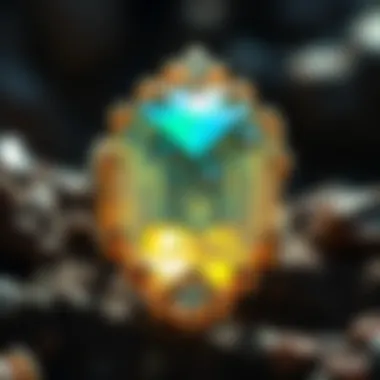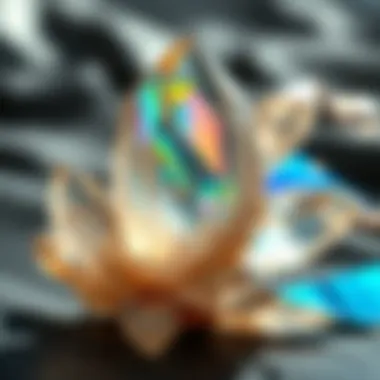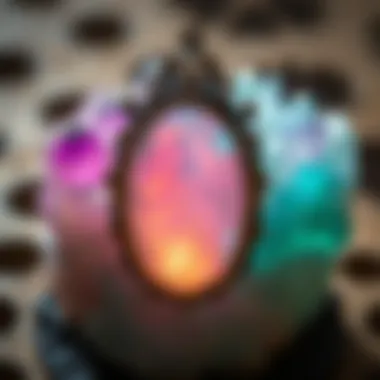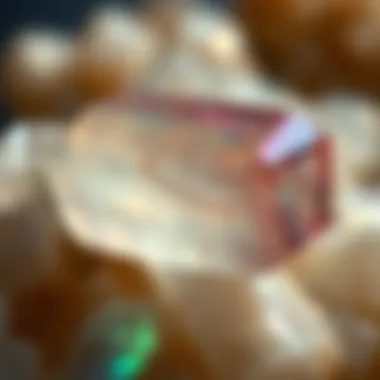Exploring the Fascinating World of Iridescent Crystals


Intro
Iridescent crystals, with their enthralling play of colors, seem to almost capture the essence of a rainbow. These geological treasures bring together not only beauty but also a deep-rooted significance within the world of geology. Many enthusiasts and collectors are drawn to their unique properties, making them a coveted addition to any collection. This article serves as a comprehensive exploration of iridescent crystals, unraveling their formation, key characteristics, and the intriguing phenomena behind their iridescence. Additionally, we will dive into the cultural significance of these gems, their role in geological studies, and how they captivate both new collectors and seasoned connoisseurs alike.
By understanding these aspects, readers will appreciate not only the aesthetic value of iridescent crystals but also their scientific importance, tying the beauty of nature with geological principles.
Understanding Iridescent Crystals
Iridescent crystals hold a unique fascination among rock hounds and geologists alike, blending nature’s artistry with the intricate dance of light. This section aims to shed light on these captivating minerals, digging into their formation, significance, and allure. Understanding iridescent crystals isn't just about appreciating their beauty; it opens a door to comprehend how these geological marvels interact with their surroundings and why they capture the imagination of collectors and enthusiasts.
Defining Iridescence
Iridescence is that magnetic phenomenon where colors shift and change based on the angle of light. Picture a soap bubble glimmering in the sun, displaying a palette of colors that seem to flow and change as you move around it. Similar effects can be observed in iridescent crystals. The term itself comes from the Latin word ‘iris,’ which means rainbow.
Iridescence in crystals typically arises from microscopic structures that affect light waves as they bounce off surfaces. This characteristic isn’t exclusive to one type of crystal; it can be found across various minerals like opal, labradorite, and even some forms of quartz. Each type showcases iridescent properties in its distinct way, making the exploration of these crystals particularly rewarding for enthusiasts seeking diversity in their collections.
Historical Context
The allure of iridescent crystals isn't a new discovery; societies have been captivated by their beauty for centuries. Ancient cultures revered these stones, attributing spiritual and practical significance to them. For instance, in various indigenous cultures, opals were believed to carry the power of invisibility, while labradorite was often associated with transformation and change—qualities frequently linked to the shimmering hues of the stones themselves.
Through the ages, these crystals have adorned crowns, jewelry, and ceremonial objects. They became symbols of wealth and power in many civilizations, often sought after by aristocrats and royalty. Over time, the scientific community began to unravel the secrets of these beauties, transitioning from mere aesthetic appreciation to a structured understanding of their formation and properties.
The fascination continues today, as geological studies draw connections between iridescence and the environmental conditions in which these crystals form. Collectors frequently fine-tune their skills based on historical precedents, leveraging age-old knowledge to identify and appreciate the magic these stones hold.
"In every iridescent crystal lies a history waiting to be explored—connecting the past with the present, in a dance that mirrors our own journeys through the light and shadow of life."
In essence, comprehending iridescent crystals involves more than just recognizing their visual splendor. It invites a deeper exploration of their narrative, which stretches back through the annals of human history, enriching the experience for both novice collectors and seasoned geologists.
Formation of Iridescent Crystals
The formation of iridescent crystals is a fascinating journey through both science and artistry. Understanding this process is essential to appreciate not just the stunning visuals these crystals present, but also their underlying geological significance. It brings to light the interplay between natural forces and elemental structures that create such captivating phenomena.
Within the geological community, geologists and mineral enthusiasts ponder the aspects of their formation as they provide insights into Earth’s processes. By grasping the mechanics behind these crystals, we delve deeper into not merely their aesthetic appeal, but their origins—how they came to be, and what they reflect about our planet.
The Role of Light
Light is the artist in this grand display of iridescence. It is the conductor of vibrant colors, yet it is also a key to understanding the mechanism that breathes life into these crystals. Each facet captures and refracts light in a unique dance, revealing flashes of rainbow colors that can shift with the observer's angle. This ability to manipulate light hinges on the internal structure of the crystal.
When white light strikes an iridescent surface, it breaks into a spectrum of colors. This phenomenon is called diffraction, which occurs at microscopic levels within the crystal's lattice. The wavelengths of light bending and overlapping can create stunning visual effects, making iridescent specimens truly striking and sought after by collectors.
Environmental Factors
The environment in which iridescent crystals form plays a critical role in their overall appearance and structure. Three major factors—temperature, pressure, and mineral composition—directly influence their characteristics.
Temperature
Temperature is perhaps the most straightforward aspect, as it governs the rate at which minerals crystallize. Warmer conditions can lead to slower crystallization, allowing for more complex structures to develop. In these instances, larger crystals with pronounced iridescence may form, flaunting vibrant colors that shift and change depending on the light source and viewing angle. However, extreme heat can sometimes cause minerals to lose their color or produce subpar formations, leading to less visually appealing crystals.
Pressure


On the flip side, pressure can dramatically reshape how crystals are formed. Higher pressures often yield denser crystal structures, making the iridescence even more pronounced. For instance, the compression during the formation of opal can create stunning layers that display vivid colors. However, the challenge lies in the balance; too much pressure can lead to defects, hampering light interaction and diminishing beauty.
Mineral Composition
The specific minerals and elements present during formation can dictate the resulting colors. Take opal for instance, known for its stunning play-of-color. Much of its iridescence is contingent upon the arrangement of silica spheres combined with minute water content. When the composition is just right, it manifests in crystals that not only dazzle but also display a mesmerizing array of colors as the light interacts. Similarly, the presence of trace elements can enhance or alter hues, giving rise to unique crystal varieties that thrill collectors.
By comprehending the interplay of these environmental factors, enthusiasts and collectors can better appreciate the complexity surrounding iridescent crystals. Each specimen, a singular product of nature’s intricate and sometimes whimsical hand, embodies a rich story waiting to be told.
Scientific Principles Behind Iridescence
Understanding the scientific principles that govern iridescence is crucial for those interested in the origins and visual marvels of iridescent crystals. These principles not only shed light on how these minerals interact with light but also on the broader implications for their formation and properties. Iridescence is a compelling feature that draws enthusiasts and collectors alike, enhancing the allure of these natural treasures.
Light Interaction with Crystals
Light interaction with crystals leads to stunning visual effects, defining iridescence itself. Crystals act like prisms, bending and refracting light waves that pass through them. When white light strikes an iridescent surface, it splits into its various spectral colors, resulting in a mesmerizing display. This interplay is a product of both the structure of the crystal and its surface texture.
For instance, in the case of opals, the microscopic silica spheres create a unique arrangement that affects how the light is scattered. When viewed from different angles, the arrangement may yield various colors, making opal one of the most captivating examples of iridescence. The play of light and color becomes a compelling dance, where the viewer's position alters the tones dramatically.
When discussing light interaction, it's also vital to mention the substrate from which a crystal derives its iridescent properties. For example, labradorite possesses a layered structure that causes internal reflections, enhancing its iridescent quality. By observing the angle and intensity of light penetrating the crystal, collectors can gain insights into its iridescence specifics. This knowledge not only enhances appreciation but also informs the collecting process.
Color Dispersion Phenomena
The concept of color dispersion is central to understanding why different iridescent crystals exhibit varied visual characteristics. Color dispersion refers to the way light separates into different wavelengths as it travels through a medium — quite like how a rainbow forms after rain. In iridescent crystals, this phenomenon can be strikingly beautiful.
Crystals like ammolite, an opal-like substance from fossilized shells, display profound color dispersion due to their heterogeneous structure. The different vibrational frequencies in the mineral correlate with various wavelengths of light, leading to breathtaking visual effects. When light hits the stone, you might notice flashes of green, teal, or even crimson, dependent on the angle from whence you view it.
Understanding color dispersion has practical implications for rock collectors, too. By recognizing how these colors manifest, collectors can make informed decisions when adding iridescent crystals to their collections. Knowing which angles or lighting conditions reveal a stone’s best features is a collectible skill that enhances the overall experience.
“Every crystal tells a story hidden within its facets and colors.”
Types of Iridescent Crystals
When one mentions iridescent crystals, a world of color and light springs to mind. These minerals are not just visually striking; they hold stories and secrets within their vibrant surfaces. Understanding the various types of iridescent crystals is essential, especially for enthusiasts and collectors, as each type boasts unique characteristics, geological significance, and beauty. Let's delve deeper into the noteworthy types, unraveling their individual charm and importance.
Iridescent Quartz
Iridescent quartz stands out as a perceived favorite among collectors due to its wide variety and accessibility. The shimmering colors that dance on its surface can be mesmerizing, often reflecting hues of blue, green, and gold. What makes it particularly interesting is its formation; the iridescence forms through the microscopic layers within the crystal that reflect light differently. This, in turn, leads to astonishing play-of-color effects.
These features not only make iridescent quartz a popular gemstone for jewelry making, but its prevalence in nature means collectors can find specimens practically in their backyards. The blend of affordability and beauty positions iridescent quartz as an attractive option for novices and seasoned collectors alike.
Opal and Its Varieties
Opal is like a chameleon, showing off a spectacular range of colors that are influenced by light. It’s a fascinating mineral that captures attention wherever present. What sets opal apart is its internal structure, which diffracts light in such a way as to produce vivid colors. Within the opal family, we find two compelling varieties: Precious Opal and Fire Opal.
Precious Opal
The hallmark of precious opal is its breathtaking play-of-color. This iridescent quality is not just a fluke; it arises from the silica spheres within the stone. The dispersion of light through these spheres creates mesmerizing patterns that can captivate an observer for minutes. It’s often described as a kaleidoscope captured inside a stone.
Due to its incredible visual appeal, precious opal is frequently sought after in fine jewelry. However, its delicate nature can make it a bit tricky to care for. Unlike tougher stones, it requires careful handling to maintain its beauty—high temperatures and sudden impacts can easily damage it. Thus, while its visual contribution to any collection is unparalleled, care considerations should not be overlooked.


Fire Opal
Turning our attention to fire opal, we notice it shines with a warm, luminous quality reminiscent of flickering flames. Unlike precious opal, fire opal showcases its color more uniformly rather than the intricate patterning typical of its precious cousin. The key characteristics of fire opal include its vibrant hues of yellow, orange, and red, which evoked a sense of warmth and energy.
Fire opal is cherished for its striking beauty and its relatively sturdy build, which makes it more practical for use in everyday jewelry. However, it can be more common to encounter fire opals that lack the same level of opalescence as precious opals. This fact sometimes leads to misunderstanding among collectors about its value. Nonetheless, fire opal serves as an exciting addition, resonating well with those who seek stones that embody a sense of passion and intensity.
Labradorite
Labradorite is another showstopper in the realm of iridescent crystals. Its unique labradorescence—a phenomenon where a spectrum of colors emerges from the stone—makes it exceptionally captivating. This crystal often exhibits shades of blue, green, gold, and even hints of red depending on the angle and light exposure. Each piece is like discovering a miniature universe trapped within rock.
For collectors, labradorite can represent a piece of the mystic. The legends surrounding it suggest that it possesses protective qualities, which only adds to its allure. Not only does it stand out for its aesthetic values, but many people see it as a conduit of inspiration and creativity. However, care must be taken; like opal, labradorite can scratch and chip easily with rough handling.
In summary, the variety of iridescent crystals from quartz to opal and labradorite offers collectors not only beauty but also insight into geological processes and cultural connections. As you explore these stones, you will surely find the personal allure that each unique crystal holds.
Collecting Iridescent Crystals
Collecting iridescent crystals is not just a pastime; it represents a journey into the heart of nature's artistry. The allure of these gems lies in their capacity to change colors and reflections based on how light interacts with their surfaces. Collectors often find these unique traits irresistible. They are usually not merely lawn ornaments. Instead, they are tokens of the remarkable geological processes that shaped the Earth. Engaging in crystal collection allows one to appreciate the planet’s hidden beauty while also reaping various benefits, which is why this topic is essential in our exploration of iridescence.
Benefits of Collecting
When one engages in the practice of collecting iridescent crystals, they embark on an enriching experience. Many collectors find that this hobby acts as a form of meditation. The focus required in identifying and selecting specimens nurtures mindfulness. Additionally, the social aspect of collecting cannot be overlooked. Enthusiasts often gather at rock shows, fairs, or online communities to share their discoveries and knowledge.
- Personal Fulfillment: The joy derived from hunting for these pieces of art is unparalleled. Each find can symbolize a personal victory.
- Educational Value: Collectors inadvertently learn a great deal about geology. The understanding of mineralogy deepens with each crystal.
- Investment Opportunity: Rare iridescent specimens can appreciate in value over time, making this more than just a hobby but a profitable venture.
Finding and Identifying Specimens
The search for iridescent crystals often feels like a treasure hunt. Knowing where to look is half the battle. Idiosyncratic locations can yield surprising finds. Popular places include riverbeds and ancient quarries where minerals naturally weather and reveal their hidden colors. Moreover, rockhounding spots vary by region, making it essential to connect with local mining clubs or forums, such as those found on Reddit.
Tips for Identification
When examining potential specimens, pay attention to a few key indicators:
- Color Play: The best iridescent crystals exhibit brilliant color shifts. If the surface shines with multiple hues, it's worth investigating further.
- Surface Texture: Smooth finishes sometimes yield better iridescence than rough ones, due to the interaction of light.
- Environmental Context: Knowing the geology of an area can significantly enhance your identification skills.
- Was that last specimen collected near water? It may have polished edges, hinting at its origin.
- Look for the presence of other minerals around—often, iridescent crystals don’t stand alone.
Preservation Techniques
Once you've amassed a collection of iridescent crystals, preserving them becomes the next crucial step. Conditions that change too drastically can affect their appearance, so storing them correctly ensures that they remain vibrant and beautiful over the years.
Preserving Your Collection
- Optimal Environment: Aim for a stable temperature and humidity level. Avoid glass display cases that heat up under sunlight.
- Cleaning: Use a gentle touch. Soft brush or cloth will help in removing dust without scratching the surface. Immediate cleaning post-discovery is advisable to prevent dirt from settling.
- Handling with Care: Always handle with clean hands or gloves to reduce oils and contaminants from affecting the crystal's surface.
"The true art of collecting lies not just in acquiring, but in preserving the stories these stones carry with them."
Thus, by deepening your understanding of collecting iridescent crystals, you not only embrace a beautiful hobby but also enter into a meaningful relationship with nature and its geological wonders.


Cultural Significance of Iridescent Crystals
The allure of iridescent crystals stretches far beyond their mesmerizing physical characteristics. Throughout centuries, various cultures have ascribed significance and meaning to these radiant geological wonders. The discussion on the cultural significance of iridescent crystals opens a window into human history, beliefs, and artistic expression.
Use in Mythology and Lore
Iridescent crystals frequently find themselves intertwined with mythology and folklore. Ancient civilizations viewed these crystals as remnants of the divine, symbols of the heavens, and much more. For example, in many Native American cultures, a crystal believed to have iridescent qualities was often regarded as a bridge between this world and the spirit realm. The shimmering surfaces were thought to reflect the influence of the celestial bodies, imbuing the crystals with protective properties.
Additionally, in Hindu traditions, certain iridescent stones like opals are considered to bring spiritual insight and clarity. Their glowing colors are thought to represent various deities, and using such stones in rituals can enhance spiritual guidance. This connection to spirituality not only highlights the cultural reverence for these crystals but also showcases their role in rituals and practices meant to inspire and protect.
"The crystal’s allure is not just in its beauty, but in the stories it carries with it, stories that connect us to cultures and beliefs that span millennia."
Art and Decoration
From art to architecture, iridescent crystals have mesmerized artists and artisans who seek to capture their essence in creative expressions. The use of these stones in art dates back thousands of years; ancient jewelry often incorporated iridescent materials, enhancing their appeal through craftsmanship and spirituality.
Particularly during the Art Nouveau movement in the late 19th and early 20th centuries, iridescent materials like glass and enamels became popular in a variety of artistic applications. Artisans skillfully manipulated light and color, with designs emulating the looks of natural iridescent crystals. Even in contemporary art, the use of iridescence reflects a modern fascination with color and movement. Many artists today utilize iridescent pigments to create captivating pieces that shift in hue based on the viewer's perspective and the light's angle.
In interior design, iridescent features provide visual intrigue and compliment a variety of aesthetics. From decorative pieces to architectural details, iridescent crystals introduce a unique blend of contemporary and classic styles that captivate beholders.
In summary, the cultural significance of iridescent crystals reveals how deeply embedded they are in human history. Their use in mythology and art showcases humanity's enduring connection with nature and the quest for beauty and meaning in the world. As we continue to explore and appreciate these stones, we also delve deeper into our own stories and those of the cultures that have revered them.
The Future of Iridescent Crystals
The exploration of iridescent crystals isn’t merely a trip down memory lane; it’s a significant look at where geology might be heading. The future of these remarkable specimens hinges on several factors, including advances in research, changes in market dynamics, and a heightened awareness of ecological responsibility. As more enthusiasts and collectors recognize the stunning visual qualities of these crystals, the interest in their sustainable sourcing and scientific investigation increases.
Advancements in Research
Recent studies are shedding light on the formation and properties of iridescent crystals. Researchers are using cutting-edge technology, such as electron microscopy and spectroscopy, to better understand the molecular structure of these gemstones. This deeper comprehension not only helps scientists in identifying new varieties but also aids in the classification of existing specimens. Some laboratories are even experimenting with synthetic methods to replicate the natural processes that create iridescence, aiming to produce quality specimens without damaging the environment.
For instance, a recent study indicated that certain non-toxic chemicals can simulate the natural conditions needed for iridescent qualities to emerge. These findings suggest a future where the allure of iridescent crystals might be accessible through artificial means, thus creating new opportunities for collectors and artists alike.
Market Trends and Eco-Conscious Collecting
The market for iridescent crystals is evolving. With growing concerns about environmental sustainability, many collectors are now leaning toward eco-conscious practices. This shift is not merely a trend; it reflects a broader awareness of the ecological footprint of mining practices. Collectors are increasingly favoring ethically sourced materials, with preference for vendors who provide thorough traceability of their specimens.
- Sustainable Sourcing: Collectors often seek crystals obtained through responsible mining operations. This ensures that they are contributing to the preservation rather than the depletion of natural resources.
- Trade Regulations: Laws governing the trade of minerals are becoming stricter. The adoption of guidelines, such as those found in the Convention on International Trade in Endangered Species (CITES), influences what collectors can purchase, steering them towards legal and ethical channels.
- Community Engagement: Social media platforms and online forums are buzzing with discussions about ethical practices in the collection and trade of iridescent crystals. Communities on sites like Reddit and Facebook are sharing knowledge about where to find ethically sourced specimens and personal experiences with collectors who prioritize eco-friendliness.
Furthermore, the popularity of iridescent crystals in decorative applications signals a burgeoning market. Artists and interior designers are increasingly clamoring to utilize these materials in their work, thereby merging art with geology, and presenting unique pieces that celebrate nature's designs.
As the scientific community and collecting circles place a premium on iridescent crystals, their future remains bright, underscoring the intricate balance between appreciation, innovation, and responsible stewardship of our natural world.
Finale
In wrapping up our exploration of iridescent crystals, it’s essential to reflect on why these natural wonders resonate so profoundly within the geological community and beyond. Their beauty captivates both scholars and collectors alike, offering more than just visual splendor; they embody a complex interplay of science, history, and culture that deserves attention.
Reflecting on the Beauty of Nature's Crystals
Iridescent crystals are not merely objects of beauty; they are tangible stories of geological processes spanning thousands to millions of years. This allure stems from their unique ability to refract light, creating colors that shift and change as one moves around them. Every glance at an iridescent stone can reveal something new, compelling observers to appreciate their complexity. The unpredictability of nature is further manifested through the varying environmental conditions that contribute to their formation, such as temperature fluctuations and mineral composition.
"The colors we see are more than aesthetic; they reflect the rich history of the earth itself."
For collectors, the hunt for these gems can be an exhilarating quest. Each specimen’s story contributes to its value—not just financially, but emotionally. This connection invigorates a vibrant community where experience and knowledge are shared, helping enthusiasts understand the science behind what they adore. The appreciation goes well beyond physical possession; it highlights the precious relationship between humanity and the natural world, fostering a deeper respect for geological phenomena.
In addition, discussions surrounding eco-conscious collecting are becoming increasingly vital. With a heightened awareness of environmental impacts, collectors are urged to source iridescent crystals responsibly. This adds another layer of meaning to what may have once been seen as mere collectibles. By considering the implications of their choices, collectors not only enjoy the beauty of these crystals but also contribute to a sustainable future for geology.







